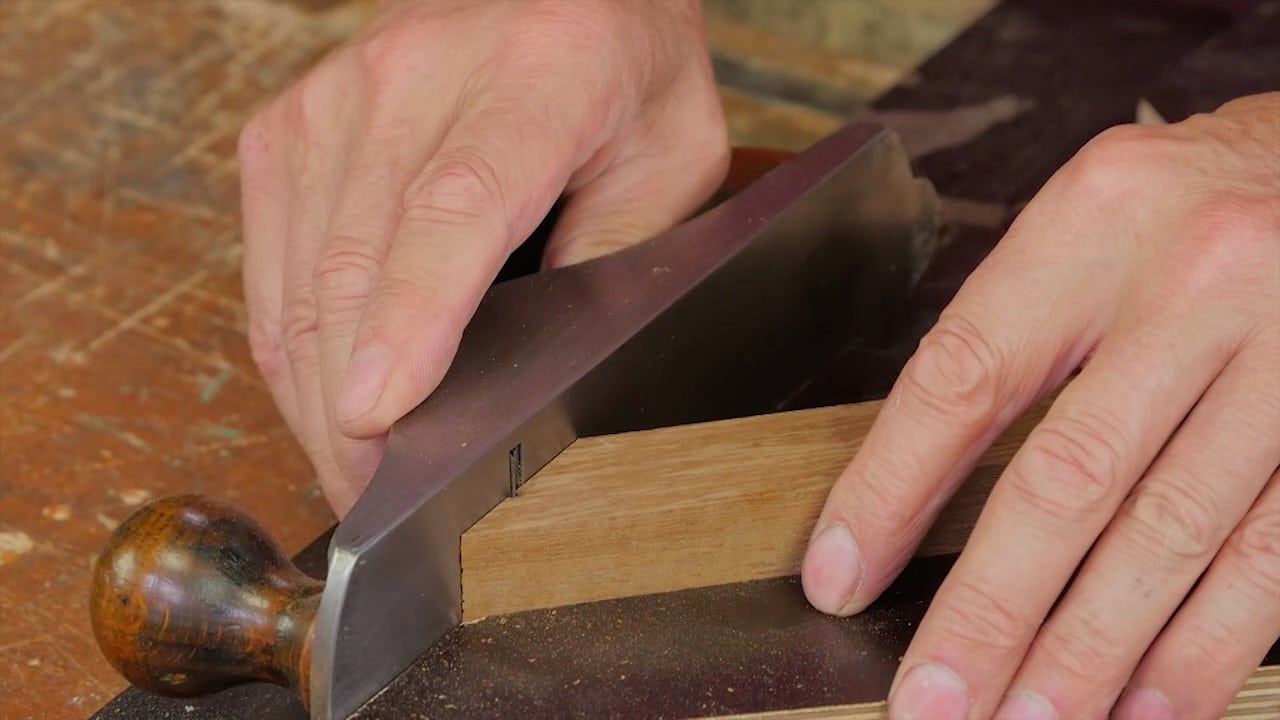Chess Board: Episode 3
Posted 27 July 2016
This is an episode in a paid series. Want to watch it? You just need to sign up as a paid member, and you can enjoy this video and many other videos we think you will love.
Once the glue has cured overnight, Paul cleans up the surfaces with a cabinet scraper. The edges are checked for square and planed for consistency ensuring they are parallel. Then the substrate board is measured and cut to size ensuring a consistent overhang, whilst minimizing tear-out. The skirt piece is grooved to receive the board and mitred to meet crisply at the corner, taking special care with the final corner.


Painstaking attention to detail,as always. A great thing for students ( no matter what our age ) to emulate.
Paul, I got butterflies in my stomach watching the final strokes on the shooting board. Wonderful lesson. Thank you.
decisions decisions it’s great when we see Paul question himself, should I shouldn’t I
great episode once again but I don’t have a plane like that to cut the groove. They are a bit expensive from Lee Valley or secondhand on ebay. Any ideas on alternatives? Would it be knife walls, saw groove walls to depth and chisel out?
For those like me who don’t have a plough plane (yet) for cutting the groove, Paul demonstrates an alternative saw kerf and chisel method here on the breadboard project. It starts at about 17:15 in.
https://woodworkingmasterclasses.com/2013/06/episode-2-2/
Thank you for a great lesson.
Yeah right at the end Paul said he’ll take just one more shaving. Maybe two. I said to myself, he’ll take three, he always takes one extra. Sure enough it was three. Wonderful watching the super tight tolerances and knowing what’s possible to aim for.
Another great episode , you obviously have to have patience when fitting the miters for sure. Learned a lot, thank you.
Steve
There is no way I can get a good edge if I plan all the way across the end grain. I beak out a chunk every time… I’ve sharpened the blade and adjusted to a very fine cut and I always have to glue a little chip back in… I guess I am not paying the preacher enough.. 🙂
Make sure the back edge is supported, if youre not using a shooting board, you can do it in the vise with a sacrificial block snug up against the edge, so no chip out.
If you ARE using a shooting board, you may have your piece too far out, so watch paul as he snugs the wood up against the plane before he starts taking strokes. Also make sure to sharpen up before you try to take a cut.
Unsupported end-grain will always chip out when unsupported on the back side, it’s physics.
Is it possible to use something other than a plough to cut the groove in the frame/skirt? I have used a thinner piece of plywood for my substrate and I don’t believe my plough can cut a groove that is thinner than 3/8″. Is it adviseable/possible to use a saw on the edges and chisel out the waste in the middle? I mean–I’m sure it’s possible, but is there a better way/alternative?
Hello David,
You could use a saw and chisel, perhaps as in the poor mans router, although it will take a lot of care. Have a look at the following FAQ page for suggestions: https://paulsellers.com/knowledge-base/plough-plane/
Thanks, Phil
I don’t recognize your plough plane, is it an early Veritas?
Hi Matthew,
This is a Stanley plane that’s no longer made but readily available on eBay.
Kind Regards,
Izzy
Greetings All,
So in watching the attention to detail with the miters and the precision of the 45 degree cuts, I was wondering about Paul’s take on some of the miter saw boxes by Stanley and Millers Falls that are on the second hand market (ebay). Sorry if this is a topic that has been talked about elsewhere that I didn’t see.
Thank you.
Hi Robert,
Paul says:
I’ve never used them because my method is so efficient. I see them used occasionally, but mostly I see them abandoned and unused which may be the story behind their real functionality.
Kind Regards,
Izzy
Thank you.
Paul, this is a great project. Thank you for all you’re doing. Have you considered starting off projects (or a separate quick video) talking about the grain properties of the wood used for the project. I’ve found that ribbon sapele has fragile grain as well – you mention this when you’re planning the miter corners. I’ve also found that the ribbon sapele has unpredictable grain – some parts are dense some are not as dense, and it sprinters unpredictably when the grain transitions through the figure. I thought it may be nice for some people to learn about the wood and how it behaves up front. Just a thought.
Thank you again!
I’m about to glue the board to the substrate and I was wondering if urea glue (Unibond 800) would be a good fit instead of wood glue. I’ve used the urea glue for marquetry as it doesnt soften with heat. My thought is that the chess squares are still laminated and maybe urea glue would serve as a better medium to prevent any future delaminating of the board joints… or am I over-engineering it
Found answer to my own question in the second half of the live Q/A with Paul and Joseph